Top Ten Types of Bonsai Maple Tree to Growing
Introduction

There are hundreds of different species of Bonsai maple tree to pick from, but it’s crucial to only plant plants that will grow in your area. Make sure your chosen acer is suited for your location by consulting the USDA plant hardiness zone map.
The majority of Bonsai maple tree can be grown in zones 5-8, however certain hardier species can be grown beyond of these limits. Japanese maple trees prefer somewhat acidic, well-drained soil; thus, your soil type will play a role. They have a hard time growing in alkaline soil and dislike being damp or dry.
However, if you don’t have the correct conditions, the good news is that Japanese maples are excellent pot plants, allowing you to customize the soil type. In colder climates, you may even relocate a potted tree to a more protected location for the winter.
You should also take into account the tree’s mature size to ensure that it will fit into your yard in the long run. Many Bonsai maple tree grow slowly and take a long time to achieve maturity. If your yard is small, though, a dwarf variety might be considered.
The best of Bonsai Maple Tree to Growing
In the coming sections, we will explain in detail the common bonsai maple tree growing.
YouTube Bonsai
1. Scolopendrifolium

Get your hands on ‘Scolopendrifolium,’ also known as ‘Shinobuga Oka,’ if you want something a little different. This A. palmatum tree’s leaves have unusually long, narrow lobes that are separated all the way down to the base.
The leaves are bright green throughout the summer, with red stalks, seed pods, and blooms. The whole effect is spectacular. This erect, spreading 15-foot tree has delicate green straps with a startling red contrast, and it thrives in Zones 5 to 9.
2. Emperor One
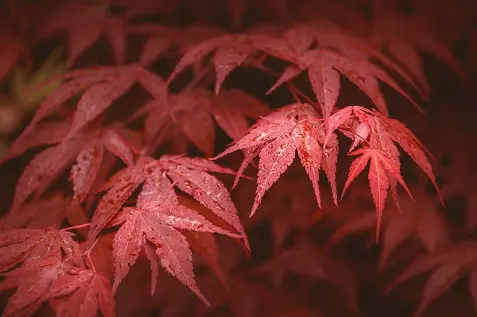
‘Emperor 1 is an upright red Japanese maple that improves on all of the qualities that people love about the Bloodgood acer,’ explains Lisa Tadewaldt, arborist and proprietor of Urban Forest Pro.
Emperor’s magnificent crimson fall leaves remain longer than other types, as well as being more resistant of early spring frosts. Zones 5-8 are recommended, while some gardeners have had success in zone 4.
‘It has a dark and distinctive black-red bark, and its brilliant – and recognizable – red hue changes from black-red to scarlet in the fall,’ Tadewaldt adds. ‘They’re just incredibly attractive trees that are also hardy,’ says the author. ‘Perfect for injecting a splash of color into your garden.’
3. Coral Bark or Sango-Kaku

Another Japanese maple with vivid coral bark is A. palmatum ‘Sango Kaku.’ Its name literally translates in mild sunlight, a close-up horizontal shot of Acer palmatum ‘Coral Bark’.
‘Sango Kaku’ is a character from the manga ‘Sango Kaku’ The leaves of this tree are bright green with red borders in the summer and turn dazzling yellow in the fall, making it hardy in Zones 5 to 8.
At 20 to 25 feet tall when fully mature, this beautiful tree has an erect habit. On a soft-focus background, a close-up square image of a ‘Coral Bark’ Japanese maple.
‘Coral Bark’ is a name for a type of coral.
‘Sango Kaku’ is perfect for adding color to your yard not only during the growing season, but also throughout the barren winter months. Does that make sense? This plant is available in #2 containers at Nature Hills Nursery.
4. Velvet Viking
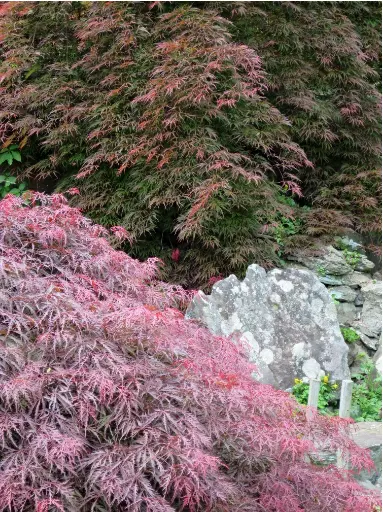
The Velvet Viking is one of the hardiest Japanese maple trees, appropriate for zones 4 through 9, according to Sons. ‘In the spring and summer, it has delicate, thin-shaped leaves and purple-red foliage, with significantly deeper purple tones in the fall.’
The Velvet Viking prefers partial shade, although in cooler locations with moderate temperatures, it may tolerate full sun. It’s a great choice for tiny gardens because it’s a dwarf type. ‘At maturity, it reaches a height of around 5 feet, with a canopy width of around 8 feet,’ Sons says.
5. Dissected Red

Traditional Red Dissected – Dissectum Atropurpureum Japanese maple tree is a real favorite ‘Its tiny mature size of 5-6 feet makes it a superb element in any landscape, and its weeping branches provide a touch of elegance,’ says the manufacturer.
The red-to-purple feathery leaves of the Red Dissected maple turn a deep orange-red color in the fall. It grows well in zones 5-8, and its size makes it one of the greatest front-yard trees.
6. Ukigumo
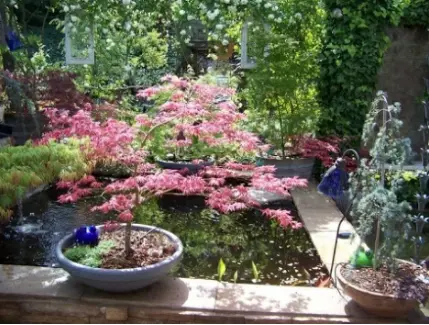
Ukigumo, or Floating Clouds, is a semi-dense upright Japanese maple tree with magnificent variegated leaf.
‘Each leaf evolves from a high-contrast pale green/white at the tips to softer pinks,’ Tadewaldt notes. ‘The white foliage makes a bold statement in your home’s otherwise classic green landscaping.
These are little trees that can be used all summer for a burst of pink or white.’ In zones 5-9. ukigumo will thrive under most soil types, ideally in partial shade.
7. Shaina
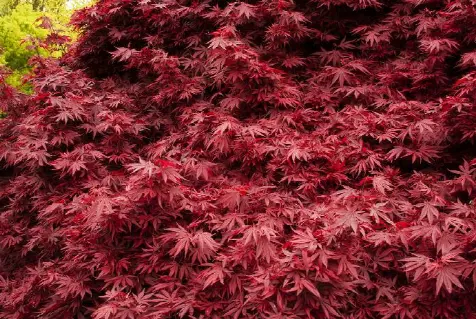
‘A superb dwarf Japanese maple tree, Shania may be small in appearance, but when fully mature, it delivers thick foliage,’ writes Sons.
The tree features bright red spring leaves that deepen to burgundy in the summer before turning bright red again in the fall. ‘Shania grows nicely in partial shade, reaching a height of 10 feet and a width of 12-14 feet,’ Sons adds. It may be grown in hardiness zones 5-9.
8. Higasayama

While Japanese maples are most beautiful in the fall when their leaves changes color, ‘Higasayama’ also puts on a lovely show in the spring. The leaves emerge from the ground with a green base and a brilliant pink exterior.
The leaves open to a creamy pink show before turning a deep green with creamy borders. With an upright, open growth habit that reaches about 18 feet tall, this A.
palmatum thrives in Zones 5 to 8. If you’re dying to add this gorgeous tree to your home, Japanese Maples and Evergreens on Amazon has it as a two-year-old plant.
9. Red Dragon Maple Bonsai

Because red dragon maple bonsai grows at a slower rate than most Japanese maple trees, it’s ideal for containers,’ containers,’ explains Sons. Its leaves are purple in the spring and turn blood-red in the fall.’ The red dragon maple bonsai can grow to be over 5 feet tall with a 6-foot spread. In zones 5-8, it thrives in both full sun and moderate shade.
10. Crimson Queen – Weeping Bonsai Maple Tree

‘Crimson Queen’ is a dwarf A. ‘Crimson Queen’ is an extremely popular tree. palmatum palm It grows to be about eight feet tall and 12 feet wide, with elegantly weeping branches, and eventually grows to be about eight feet tall and 12 feet wide. Its shape can give your garden an interesting dimension.
On a dark background, a close-up horizontal shot of the leaf of Acer ‘Crimson Queen.’ ‘Crimson Queen’ is a song about a woman who wears Crim Depending on the quantity of light it receives; the foliage can appear to have a distinct tint.
The delicate leaves turn maroon in the sun. The color is a brighter red in areas that receive more light. The leaves turn a brilliant color in the fall.
Zones 5 to 9 are suitable for ‘Crimson Queen.’ You may get one for your garden at Nature Hills Nursery, where you can buy a three-year-old plant.

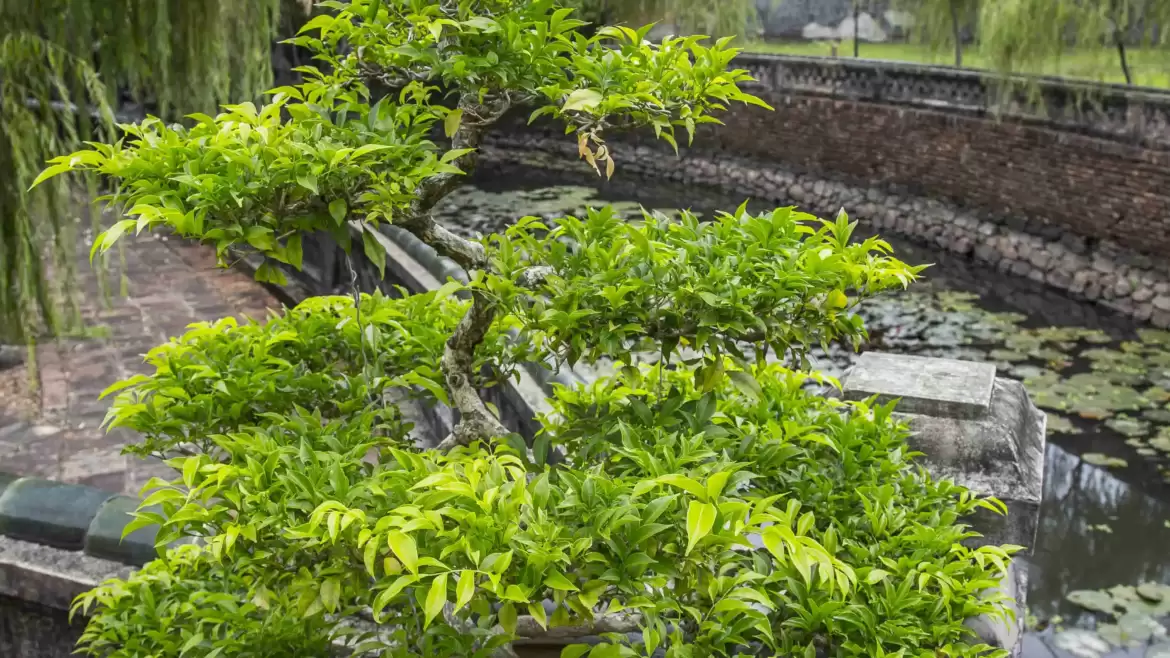



2 Comments